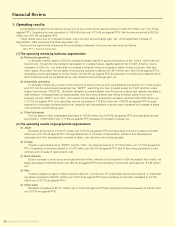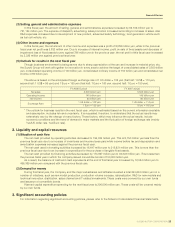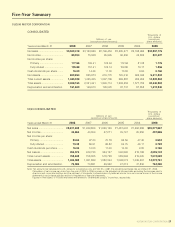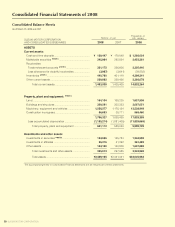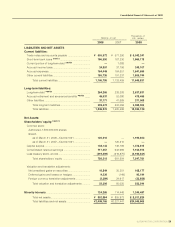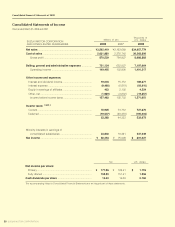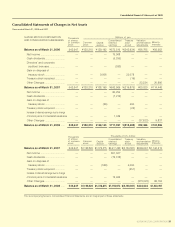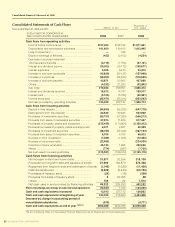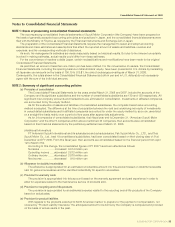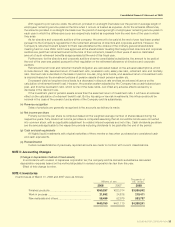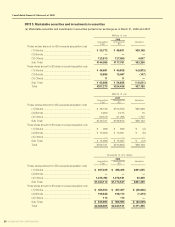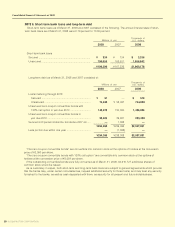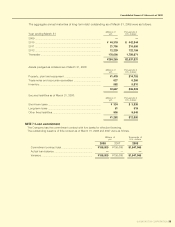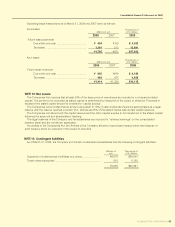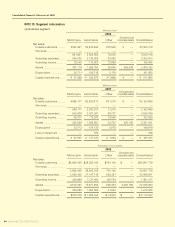Suzuki 2008 Annual Report Download - page 35
Download and view the complete annual report
Please find page 35 of the 2008 Suzuki annual report below. You can navigate through the pages in the report by either clicking on the pages listed below, or by using the keyword search tool below to find specific information within the annual report.
34 SUZUKI MOTOR CORPORATION
(f) Marketable securities, investment in securities
The companies and its subsidiaries hold securities of listed companies, which have a risk of price fluctuations, and
non-listed companies whose stock prices are difficult to be evaluated.
If we judge the decline in investment value is not temporary, we recognize revaluation loss based on the reasonable
standard. If the stock market falls, we may incur significant revaluation losses of marketable securities.
Securities have to be classified into four categories: trading securities; held-to-maturity debt securities; investments
of the Company in equity securities issued by unconsolidated subsidiaries and affiliates; and other securities.
According to this classification, securities held by the Company and its subsidiaries are other securities. Other
securities for which market quotations are available are stated at fair value by the closing date’s market value method.
Unrealized gains or losses are included in a component of net assets at a net-of-tax amount, and gains or losses from
sales of securities are recognized on cost determined by the moving average method.
Other securities for which market quotations are unavailable are stated at cost by a moving average method.
(g) Hedge accounting
Gains or losses arising from changes in fair value of the derivatives designated as “hedging instruments” are
deferred as an asset or liability and included in net profit or loss in the same period during which the gains and losses
on the hedged items or transactions are recognized.
The derivatives designated as hedging instruments by the Company and its subsidiaries are principally interest
swaps and forward exchange contracts. The related hedged items are trade accounts receivable and investments in
securities.
The Company and its subsidiaries have a policy to utilize the above hedging instruments in order to reduce our
exposure to the risk of interest rate and foreign exchange fluctuation. Thus, our purchases of the hedging instruments
are limited to, at maximum, the amounts of the hedged items. The Company and its subsidiaries evaluate effectiveness
of its hedging activities by reference to the accumulated gains or losses on the hedging instruments and the related
hedged items from the commencement of the hedges.
(h) Foreign currency translation
All monetary assets and liabilities denominated in foreign currencies, whether long-term or short-term are translated
into Japanese yen at the exchange rates prevailing at the balance sheet date. Resulting gains and losses are included
in net profit or loss for the period.
Assets and liabilities of the foreign subsidiaries and affiliates are translated into Japanese yen at the exchange rates
prevailing at the balance sheet date.
The components of net assets are translated into Japanese yen at their historical rates. Profit and loss accounts for
the year are translated into Japanese yen using the average exchange rate during the year. Differences in yen amounts
arising from the use of different rates are presented as “foreign currency translation adjustments” in the net assets and
minority interests.
(i) Inventories
Inventories are stated at the lower of cost or market value, cost being determined principally by the periodic average
method.
(j) Property, plant and equipment
Property, plant and equipment are stated at cost. Depreciation is principally computed by the declining-balance
method based on estimated useful lives of the assets (mainly 3-75 years).
(k) Leases
Finance lease transactions are recorded based on ordinary rental transaction except for the case where ownership
of the lease assets is considered to be transferred.
(l) Income taxes
The provision for income taxes is computed based on the income before income taxes included in Consolidated
Statements of Income. The assets and liability approach is adopted to recognize deferred tax assets and liabilities for
the expected future tax consequences of temporary differences between the carrying amounts and the tax bases of
assets and liabilities.
In making a valuation for the possibility of collection of deferred tax assets, the Company and its subsidiaries
estimate their future taxable income reasonably. If the estimated amount of future taxable income decrease, deferred tax
assets may decrease and income taxes expenses may be posted.
(m) Accrued retirement and severance benefits
In order to allow for payment of employees’ retirement benefits, based on estimated amount of retirement benefits
liabilities and pension assets at the end of this fiscal year, the allowable amount which occurs at the end of this fiscal
year is appropriated.
Consolidated Financial Statements of 2008


